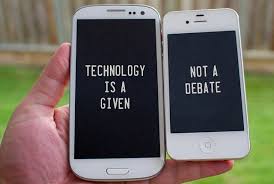
It has been many years since libraries have only been about books – and some would argue that’s never been the sole aim of public libraries. Rather they are important community assets, providing critical services and transforming lives.
My local library is at Parkdale – a 3-minute train ride or 15 minutes walk away from where I live in Mordialloc and part of a network of libraries in the City of Kingston.
We are lucky because years ago with the onslaught of computer technology and digital books and proponents of neoliberalism’s desire to privatise and ‘monetise’ there were plenty of people murmuring about whether libraries were worth funding.
Like many public facilities and services, they came under pressure to justify their existence.
‘Books are outdated,’ a common enough catch cry…
In The New Penguin Compact English dictionary (updated 2000) the definition of Library is:
1. a room, building or other place in which books, periodicals, CDs, videos etc are kept for reference or borrowing by the public
2. A collection resembling or suggesting a library
3. A series of related books issued by a publisher
Kingston libraries offer:
- books in large and regular print, audio books, eAudiobooks &eBooks
- magazines, music CD, DVDs, BluRays & Wi games
- Wi-Fi and computers with internet access
- computer & internet classes
- programs for children – storytime tiny tots, book bugs & school holiday programs
- Readz teen book club
- eLibrary resources
- author talks and workshops
- items in community languages
- comprehensive genealogy collection & computers for research
- local history resources

Moving with the times…
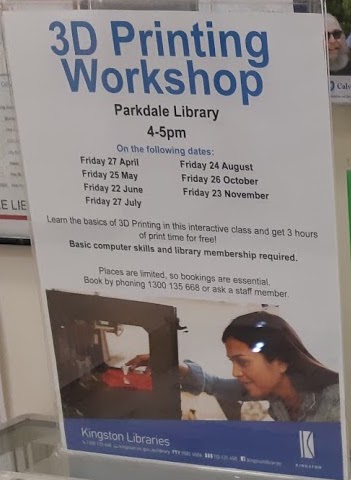
3D Printing is an emerging technology and libraries and schools are investing in printers. When I saw these free workshops advertised I booked myself in.
I’d seen a 3D printer in action in 2014 when I spent a long weekend in Ballarat at Easter time and there was a festival happening. The Ballarat Mechanics Institute had a demonstration of a 3D printer but the room was crowded and the queue to get near the machine long, so I didn’t really learn anything except that someone had printed a row of green plastic figurines to amuse any children who’d turn up – and they were the majority of the audience.
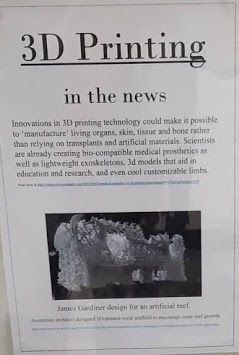 In October 2014, 3D printers were again in the news when Professor Peter Choong, led a medical team at St Vincent’s Hospital Melbourne and implanted a 3D-printed titanium replica of 71-year-old Len Chandler’s right heel after he was diagnosed with cartilage cancer.
In October 2014, 3D printers were again in the news when Professor Peter Choong, led a medical team at St Vincent’s Hospital Melbourne and implanted a 3D-printed titanium replica of 71-year-old Len Chandler’s right heel after he was diagnosed with cartilage cancer.
My brother-in-law was in St Vincent’s at the time recovering from having several toes amputated because of his diabetes so the world first operation at the hospital was the main topic of conversation!
The opportunity to learn how to use the technology too good to miss.
An Introduction by Alan, the Librarian
3D printers are commonly associated with plastic – the same substance used to make Lego is the most common plastic used.
It is a filament – a thread fed through a tube into an extruder. The plastic gets hot – 240’ centigrade, the melting temperature required to take the plastic off when dried.
PLA also common with the melting temperature cooler at 190’ centigrade. It gives a more polished finish but a lot harder to take off the machine because more brittle.
ABS and other plastic easier to take off when dried.
More Than Just Plastic
- 3D printers also use metal and at an industrial level, they use layers.
- 3D printers also use paper in layers.
- 3D printers also use food – This developed with the idea of addressing malnutrition and/or feeding the military, making edible objects; a mini-ecosystem
- 3D printers used in medicine – making copies of hearts to see if there are holes and also making prosthetics.
A Parkdale Library customer printed a prosthetic hand for his grandfather.
3D Printing in the news…
Innovations in 3D printing technology could make it possible to ‘manufacture’ living organs, skin, tissue and bone rather than relying on transplants and artificial materials. Scientists are already creating bio-compatible prosthetics as well as lightweight exoskeletons, 3D models that aid in education and research, and even cool customizable limbs.
The printers enable cheap production and easy design method. Many of the designs available are free under a Creative Common License.

The Process
Select how your design will be printed remembering to factor in how much strength may be required to support whatever you are printing to get the shape and proportion you want. A lot depends on the thickness and weight of your object.
The time it takes to print will depend on the size and thickness – a thin bookmark may take a half hour to print, thicker objects 48 hours. Fluffy the three-headed pet of Hagrid in Harry Potter took two days. It was a 6-inch solid object and took less than a reel of the plastic thread, which costs $25 a reel.
The printer the library owns only prints objects in a single colour and the reels of thread we could choose from were primary colours. (I chose green for my object.)
- After a look through the designs available, you load a design from the software already on the computer.
- Follow digital track (data loaded) and save on an SD card like a camera.
- Think of a design and imagine it in 3D – as a solid cube
- The software doesn’t tell you when support is needed – you have to factor that in when you design. eg, if printing a drawer you have to remember there needs to be a space
Objects are printed on a raft – this supports the object and helps with removal from the heat platform.
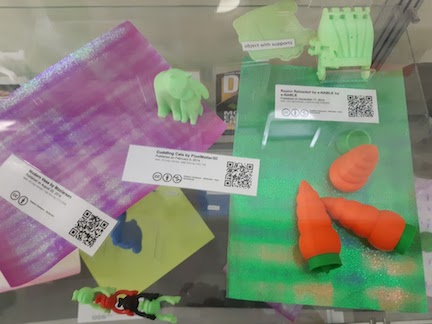
Designs using software .spl and .obj are compatible with the library computer. The printer is Duratrax bought for $3000 two years ago.
Customers have found it useful – a man needed a plastic component to fix a window blind but the component was unavailable in Australia and out of date with the product no longer made. He asked the European company to send a file compatible with Parkdale’s 3D printer and he printed off the part!
Kids have completed projects too using the printer.
We were all encouraged to design and print an object – the first 3 hours of printing free, $5.00 for every hour of printing after that, with a maximum of $25.00 (the cost of a reel of the thread).

There will be a failure to print if the power supply is interrupted while the object is being printed.
Once cleaners pulled out the plug so the print had to be started again!
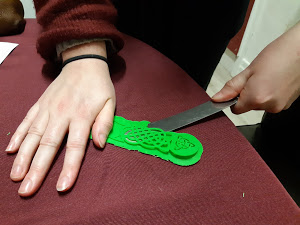
I chose a ‘Celtic’ bookmark, the design quite intricate. It was calculated to take 1hr and 26 minutes to print.
I picked it up yesterday and my daughter, Mary Jane removed the backing raft.
An old dog has learnt a new trick!








Wow, what fun! I toyed with going to that workshop too, but I couldn’t see how I might ever be able to use one… now I know:)
LikeLiked by 1 person
I was interested just to see how it all came together and didn’t know there were so many software design programs – and how many are free to use. And yet when I think about it, why wouldn’t there be – I’m inundated with adverts and writing blogs trying to get me to buy software so why not in this field. Like you, I thought is this just for techy-types or making plastic objects and my goodness we have enough of those in the world – but the medical possibilities are amazing and I was gobsmacked when I heard about 3D printing food and I had no idea of putting metal 3D printers in the same thought box!
When Alan told the story of a customer printing a part for a roller blind that won me over – what a good idea to fix and repair rather than adding to the landfill waste we are being smothered by! I printed a bookmark because I knew I would use that – unfortunately, I was not imaginative or crafty enough to see something in the pages of designs offered and think, oh, I can adapt that, or that’d look nice…
LikeLike
Impressive article Mairi on a miraculous subject and loved the Celtic bookmark. Well done.
LikeLiked by 1 person
Thanks for reading Kaye. The workshop opened my eyes too. Can’t take too much credit for The bookmark because it was a free design needing minimal adjustment. Don’t think I’ll ever be clever enough to make something from scratch.
LikeLiked by 1 person